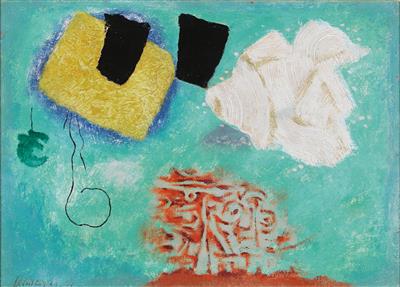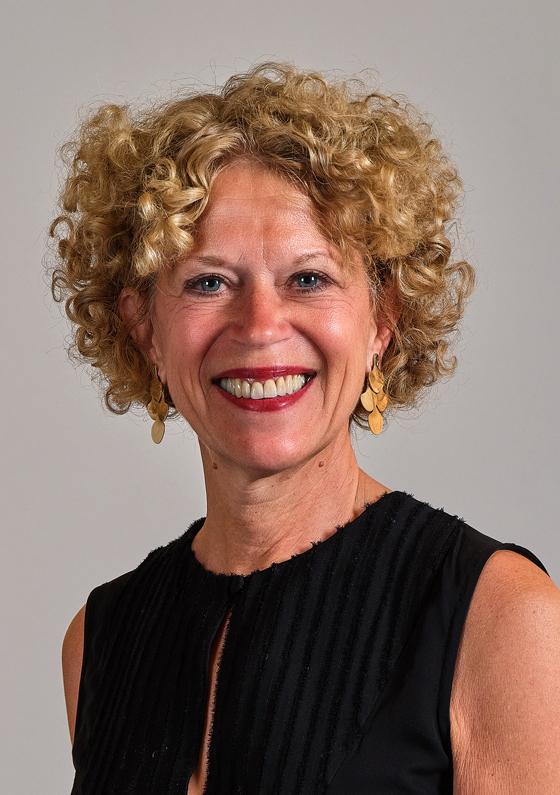Willi Baumeister *

(Stuttgart 1889–1955)
Lyrik mit Kammzug auf Blau-Grün (Lyric on blue and green background), signed, dated baumeister 54 (incised), oil, synthetic resin, filler on masonite, 34 x 47.5 cm, framed, (PS)
Provenance:
Galleria del Fiore, Milan Studio d’Arte ‘La Medusa’ Rome, 1957 (gallery label)
Pietro Campilli, Rome
Private Collection, Europe
Literature:
Will Grohmann, Willi Baumeister, Leben und Werk, Köln 1963, no. 1629, p. 348 (with ill.)
Peter Beye, Felicitas Baumeister, Willi Baumeister Werkkatalog der Gemälde, Vol II, no. 2090 (with ill.)
Exhibited:
Galleria del Fiore, Willi Baumeister, Milan 1955
Studio d’Arte, ‘La Medusa’ Rome, exh. cat. no. 4 (with ill.)
As one of the most important representatives of abstract painting, Willi Baumeister belongs without doubt to the avant-garde of postwar Europe. In broad terms, the artist‘s work reflects the development of abstract painting in Germany. While his first works remain wholly under the influence of his academic training under Adolf Hölzel, his later groups of works reveal a constant search for new means of artistic expression, an impulse towards abstraction, and concern for the autonomy of form and colour.
Although the artist was only in his early 60s, his late work already takes on the character of a legacy. After 1950, Willi Baumeister combined many currents, developments and ideas from his own œuvre self-referentially into new visual creations, yet trod entirely new paths of artistic freedom. The scope of Baumeister‘s visual invention in his later work stretches wide: it extends from his non-representational ‚ideograms‘, which recall calligraphy, to powerfully expressive relief images. What is common to them all is the increasingly symbolic character of his work.
In the work to be auctioned here, too, the reddish-hued forms in the lower part of the picture seem symbolic, evoking associations of natural forms or even hieroglyphics; yet they resist decoding. Comparable to his contemporary Max Ernst in his enjoyment of experimentation, Willi Baumeister also applies himself intensively to the treatment of the surface. The autonomous, plastic layers of this work have been applied using putty, which gives an intentionally matt effect to the coloured areas, and which he models in relief or scores with ornamental furrows by means of his repeatedly used ‚combing technique‘. In part further reinforced by a dark outline, this results in a simple, abstracted space consisting of a visual foreground and background. Rest and movement are mutually dependent on one another in this free play of forms; representation and abstraction merge to produce a successful symbiosis.
With the azure-blue colour gradations of its painted surface, the picture appears relatively bright and, in this way, reflects the joyous affirmation of life that characterises Willi Baumeister‘s pictures of the postwar years. It is therefore no surprise that these colourful compositions from the 1950s are the artist‘s most sought-after works on the international auction market.
Provenance:
Galleria del Fiore, Milan Studio d’Arte ‘La Medusa’ Rome, 1957 (gallery label)
Pietro Campilli, Rome
Private Collection, Europe
Literature:
Will Grohmann, Willi Baumeister, Leben und Werk, Köln 1963, no. 1629, p. 348 (with ill.)
Peter Beye, Felicitas Baumeister, Willi Baumeister Werkkatalog der Gemälde, Vol II, no. 2090 (with ill.)
Exhibited:
Galleria del Fiore, Willi Baumeister, Milan 1955
Studio d’Arte, ‘La Medusa’ Rome, exh. cat. no. 4 (with ill.)
As one of the most important representatives of abstract painting, Willi Baumeister belongs without doubt to the avant-garde of postwar Europe. In broad terms, the artist‘s work reflects the development of abstract painting in Germany. While his first works remain wholly under the influence of his academic training under Adolf Hölzel, his later groups of works reveal a constant search for new means of artistic expression, an impulse towards abstraction, and concern for the autonomy of form and colour.
Although the artist was only in his early 60s, his late work already takes on the character of a legacy. After 1950, Willi Baumeister combined many currents, developments and ideas from his own œuvre self-referentially into new visual creations, yet trod entirely new paths of artistic freedom. The scope of Baumeister‘s visual invention in his later work stretches wide: it extends from his non-representational ‚ideograms‘, which recall calligraphy, to powerfully expressive relief images. What is common to them all is the increasingly symbolic character of his work.
In the work to be auctioned here, too, the reddish-hued forms in the lower part of the picture seem symbolic, evoking associations of natural forms or even hieroglyphics; yet they resist decoding. Comparable to his contemporary Max Ernst in his enjoyment of experimentation, Willi Baumeister also applies himself intensively to the treatment of the surface. The autonomous, plastic layers of this work have been applied using putty, which gives an intentionally matt effect to the coloured areas, and which he models in relief or scores with ornamental furrows by means of his repeatedly used ‚combing technique‘. In part further reinforced by a dark outline, this results in a simple, abstracted space consisting of a visual foreground and background. Rest and movement are mutually dependent on one another in this free play of forms; representation and abstraction merge to produce a successful symbiosis.
With the azure-blue colour gradations of its painted surface, the picture appears relatively bright and, in this way, reflects the joyous affirmation of life that characterises Willi Baumeister‘s pictures of the postwar years. It is therefore no surprise that these colourful compositions from the 1950s are the artist‘s most sought-after works on the international auction market. In every moment / in every thing / eternity is present
Specialist: Dr. Petra Maria Schäpers
 Dr. Petra Maria Schäpers
Dr. Petra Maria Schäpers
+49 211 2107747
petra.schaepers@dorotheum.de
24.11.2015 - 18:00
- Estimate:
-
EUR 70,000.- to EUR 90,000.-
Willi Baumeister *
(Stuttgart 1889–1955)
Lyrik mit Kammzug auf Blau-Grün (Lyric on blue and green background), signed, dated baumeister 54 (incised), oil, synthetic resin, filler on masonite, 34 x 47.5 cm, framed, (PS)
Provenance:
Galleria del Fiore, Milan Studio d’Arte ‘La Medusa’ Rome, 1957 (gallery label)
Pietro Campilli, Rome
Private Collection, Europe
Literature:
Will Grohmann, Willi Baumeister, Leben und Werk, Köln 1963, no. 1629, p. 348 (with ill.)
Peter Beye, Felicitas Baumeister, Willi Baumeister Werkkatalog der Gemälde, Vol II, no. 2090 (with ill.)
Exhibited:
Galleria del Fiore, Willi Baumeister, Milan 1955
Studio d’Arte, ‘La Medusa’ Rome, exh. cat. no. 4 (with ill.)
As one of the most important representatives of abstract painting, Willi Baumeister belongs without doubt to the avant-garde of postwar Europe. In broad terms, the artist‘s work reflects the development of abstract painting in Germany. While his first works remain wholly under the influence of his academic training under Adolf Hölzel, his later groups of works reveal a constant search for new means of artistic expression, an impulse towards abstraction, and concern for the autonomy of form and colour.
Although the artist was only in his early 60s, his late work already takes on the character of a legacy. After 1950, Willi Baumeister combined many currents, developments and ideas from his own œuvre self-referentially into new visual creations, yet trod entirely new paths of artistic freedom. The scope of Baumeister‘s visual invention in his later work stretches wide: it extends from his non-representational ‚ideograms‘, which recall calligraphy, to powerfully expressive relief images. What is common to them all is the increasingly symbolic character of his work.
In the work to be auctioned here, too, the reddish-hued forms in the lower part of the picture seem symbolic, evoking associations of natural forms or even hieroglyphics; yet they resist decoding. Comparable to his contemporary Max Ernst in his enjoyment of experimentation, Willi Baumeister also applies himself intensively to the treatment of the surface. The autonomous, plastic layers of this work have been applied using putty, which gives an intentionally matt effect to the coloured areas, and which he models in relief or scores with ornamental furrows by means of his repeatedly used ‚combing technique‘. In part further reinforced by a dark outline, this results in a simple, abstracted space consisting of a visual foreground and background. Rest and movement are mutually dependent on one another in this free play of forms; representation and abstraction merge to produce a successful symbiosis.
With the azure-blue colour gradations of its painted surface, the picture appears relatively bright and, in this way, reflects the joyous affirmation of life that characterises Willi Baumeister‘s pictures of the postwar years. It is therefore no surprise that these colourful compositions from the 1950s are the artist‘s most sought-after works on the international auction market.
Provenance:
Galleria del Fiore, Milan Studio d’Arte ‘La Medusa’ Rome, 1957 (gallery label)
Pietro Campilli, Rome
Private Collection, Europe
Literature:
Will Grohmann, Willi Baumeister, Leben und Werk, Köln 1963, no. 1629, p. 348 (with ill.)
Peter Beye, Felicitas Baumeister, Willi Baumeister Werkkatalog der Gemälde, Vol II, no. 2090 (with ill.)
Exhibited:
Galleria del Fiore, Willi Baumeister, Milan 1955
Studio d’Arte, ‘La Medusa’ Rome, exh. cat. no. 4 (with ill.)
As one of the most important representatives of abstract painting, Willi Baumeister belongs without doubt to the avant-garde of postwar Europe. In broad terms, the artist‘s work reflects the development of abstract painting in Germany. While his first works remain wholly under the influence of his academic training under Adolf Hölzel, his later groups of works reveal a constant search for new means of artistic expression, an impulse towards abstraction, and concern for the autonomy of form and colour.
Although the artist was only in his early 60s, his late work already takes on the character of a legacy. After 1950, Willi Baumeister combined many currents, developments and ideas from his own œuvre self-referentially into new visual creations, yet trod entirely new paths of artistic freedom. The scope of Baumeister‘s visual invention in his later work stretches wide: it extends from his non-representational ‚ideograms‘, which recall calligraphy, to powerfully expressive relief images. What is common to them all is the increasingly symbolic character of his work.
In the work to be auctioned here, too, the reddish-hued forms in the lower part of the picture seem symbolic, evoking associations of natural forms or even hieroglyphics; yet they resist decoding. Comparable to his contemporary Max Ernst in his enjoyment of experimentation, Willi Baumeister also applies himself intensively to the treatment of the surface. The autonomous, plastic layers of this work have been applied using putty, which gives an intentionally matt effect to the coloured areas, and which he models in relief or scores with ornamental furrows by means of his repeatedly used ‚combing technique‘. In part further reinforced by a dark outline, this results in a simple, abstracted space consisting of a visual foreground and background. Rest and movement are mutually dependent on one another in this free play of forms; representation and abstraction merge to produce a successful symbiosis.
With the azure-blue colour gradations of its painted surface, the picture appears relatively bright and, in this way, reflects the joyous affirmation of life that characterises Willi Baumeister‘s pictures of the postwar years. It is therefore no surprise that these colourful compositions from the 1950s are the artist‘s most sought-after works on the international auction market. In every moment / in every thing / eternity is present
Specialist: Dr. Petra Maria Schäpers
 Dr. Petra Maria Schäpers
Dr. Petra Maria Schäpers
+49 211 2107747
petra.schaepers@dorotheum.de
|
Buyers hotline
Mon.-Fri.: 10.00am - 5.00pm
kundendienst@dorotheum.at +43 1 515 60 200 |
| Auction: | Modern Art |
| Auction type: | Saleroom auction |
| Date: | 24.11.2015 - 18:00 |
| Location: | Vienna | Palais Dorotheum |
| Exhibition: | 14.11. - 24.11.2015 |
